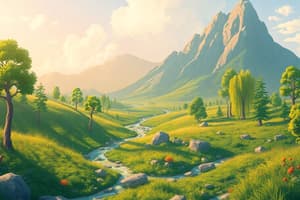Podcast
Questions and Answers
What is the primary source of energy for ecosystems?
What is the primary source of energy for ecosystems?
- The soil
- The moon
- The sun (correct)
- Ocean currents
Which organisms are classified as producers in the African Savanna?
Which organisms are classified as producers in the African Savanna?
- Giraffes
- Trees (correct)
- Baboons
- Lions
What is ecological efficiency when discussing energy transfer in ecosystems?
What is ecological efficiency when discussing energy transfer in ecosystems?
- The percentage of energy transferred to the next trophic level (correct)
- The total biomass produced
- The total number of organisms in a habitat
- The amount of light absorbed by plants
Which type of consumer eats both plants and animals?
Which type of consumer eats both plants and animals?
What limits productivity in a mature forest according to the factors mentioned?
What limits productivity in a mature forest according to the factors mentioned?
In the trophic pyramid, which level includes herbivores?
In the trophic pyramid, which level includes herbivores?
Which of the following is an example of a detritivore?
Which of the following is an example of a detritivore?
The efficiency of energy transfer between trophic levels is typically around what percentage?
The efficiency of energy transfer between trophic levels is typically around what percentage?
Flashcards
Limiting Factors
Limiting Factors
Environmental conditions that restrict the growth of organisms, like light and soil nutrients.
Productivity
Productivity
The measure of the output of energy or biomass in an ecosystem, often concerning time and space.
Producers
Producers
Organisms that make their own food through processes like photosynthesis, e.g., plants and algae.
Autotrophs
Autotrophs
Signup and view all the flashcards
Trophic Pyramid
Trophic Pyramid
Signup and view all the flashcards
Ecological Efficiency
Ecological Efficiency
Signup and view all the flashcards
Food Webs
Food Webs
Signup and view all the flashcards
Decomposers
Decomposers
Signup and view all the flashcards
Study Notes
Limiting Factors
- Light levels at ground level in a mature forest are a limiting factor, likely phosphorus toxicity.
- Certain soil nutrients (likely phosphorus) are another limiting factor in ecosystems.
Productivity
- Productivity is a measure of the output.
- Four factors support high productivity: light, water, nutrients (NPK), and temperature.
- Organisms that create food in an ecosystem are producers, also known as autotrophs.
- Autotrophs include plants, algae, and bacteria.
Measuring Productivity
- Productivity is measured as a rate, which is the amount per unit space and time.
Food Webs and Energy in Ecosystems
- Food webs allow examination of feeding relationships.
- Feeding roles:
- Producers: make their own food.
- Herbivores: eat vegetation.
- Carnivores: eat other animals.
- Detritivores: eat dead organic matter (invertebrates).
- Decomposers (microbes): recycle nutrients in food.
Energy Flow and Food Webs
- Energy transformation is less than 100% efficient.
- The trophic pyramid (energy pyramid) shows how feeding levels transfer energy.
- Producers occupy the base.
- Primary consumers (herbivores) occupy the second tier.
- Secondary consumers occupy the third tier.
- Predators occupy the top tier.
Ecological Efficiency
- The trophic pyramid reveals ecological efficiency throughout several levels.
- Energy flows through an ecosystem.
- Only about 10% of energy is able to build at the next trophic level.
Energy Review
- Energy moves through an ecosystem as it flows.
- The source of energy for every ecosystem is the sun.
- The sun provides energy to producers who convert it to chemical energy.
- A trophic pyramid shows energy transfer at each level.
- Primary consumers occupy the second trophic level.
- When moving from one trophic level to another, the energy transfer is called ecological efficiency.
- 10% of energy is passed to the next level.
African Savanna Example
- Producer: trees (acacia, etc.)
- Herbivore: giraffe
- Carnivore: lion
- Omnivore: baboon
- Detritivore/Decomposers: bacteria, termites, fungi.
Studying That Suits You
Use AI to generate personalized quizzes and flashcards to suit your learning preferences.




